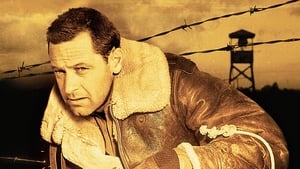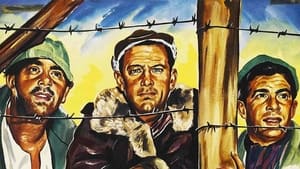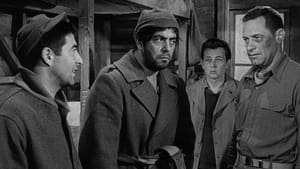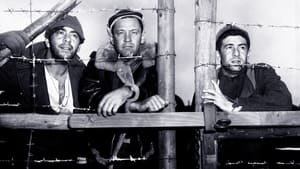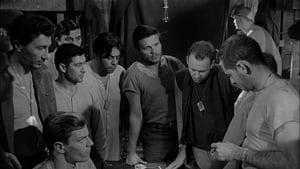Contact: [email protected]
Video Sources 0 Views
- Watch trailer
- Stalag 17


Synopsis
Table of Contents
ToggleStalag 17 (1953): A Captivating Dive into the Depths of War and Wit Review

Genre: War Drama
Director: Billy Wilder
Cast: William Holden, Don Taylor, Otto Preminger
Introduction
“Stalag 17” (1953) remains a hallmark of classic cinema, standing as a poignant reminder of the human spirit’s resilience in the face of adversity. Directed by the legendary Billy Wilder, this war drama takes audiences on a compelling journey into the heart of a German prisoner-of-war camp during World War II. In this article, we’ll unravel the layers of intrigue and camaraderie within “Stalag 17,” exploring its significance in the landscape of cinema and the enduring impact it has left on audiences worldwide.
Check The Full Colorized Movies List
Check Our Colorized Movies Trailer Channel
Understanding Stalag 17: Director, Cast, and Genre
Under the masterful direction of Billy Wilder, “Stalag 17” brings to life the harrowing experiences of American prisoners of war. Led by the incomparable William Holden, the cast delivers stellar performances, with Don Taylor and Otto Preminger adding depth to the ensemble. Positioned within the war drama genre, the film transcends mere entertainment, offering a profound reflection on the human condition in times of conflict.
Exploring the World of Stalag 17: Plot and Characters
Set within the confines of Stalag 17, a German POW camp, the film follows the trials and tribulations of a group of American prisoners. Amidst the monotony of camp life and the ever-looming threat of escape attempts, suspicion arises when evidence suggests the presence of a traitor among them. As tensions escalate, the prisoners must navigate a web of deception and betrayal to uncover the truth and safeguard their survival.
The Art of Film Colorization
Film colorization serves as a transformative medium, breathing new life into classic works and offering contemporary audiences a fresh perspective. In the case of “Stalag 17,” colorization enriches the film’s visual palette, enhancing its wartime setting and conveying the emotional depth of its characters’ experiences. From the bleakness of the prison barracks to the vibrant hues of the surrounding landscape, colorization adds depth and dimension to the storytelling, allowing viewers to immerse themselves fully in the world of the film.
Early Colored Films: A Brief History
The emergence of early colored films marked a revolutionary shift in cinematic storytelling, ushering in a new era of visual expression. From the painstaking hand-tinting of individual frames to the advent of advanced colorization techniques, filmmakers embraced color as a powerful tool for enhancing narrative impact and stimulating audience engagement. With “Stalag 17,” colorization breathes fresh life into a timeless classic, inviting viewers to experience its story in a dynamic and immersive new way.
Stalag 17 and Its Early Colored Version
The decision to release “Stalag 17” in a colorized format speaks to the film’s enduring relevance and universal appeal. By embracing colorization, filmmakers honor the legacy of the original work while introducing it to a new generation of viewers. The early colored version of “Stalag 17” offers audiences a unique opportunity to rediscover the film’s timeless themes and powerful performances in a visually stunning and emotionally resonant presentation.
The Debate Over Film Colorization
While the practice of film colorization has its proponents and detractors, there is no denying its impact on the cinematic landscape. Advocates argue that colorization breathes new life into classic works, revitalizing them for contemporary audiences and preserving their cultural relevance for future generations. Critics, however, contend that colorization compromises the integrity of the original film, diluting its artistic vision and historical authenticity. Ultimately, the debate over film colorization reflects broader questions about the intersection of art, technology, and cultural preservation in the digital age.
Examining Stalag 17 as an Early Colored Film
As we examine “Stalag 17” in its early colored version, we are treated to a visual feast of vibrant hues and evocative imagery. Colorization enhances the film’s emotional resonance, immersing viewers in the stark realities of war and captivity. From the desolation of the prison compound to the camaraderie of the prisoners, colorization elevates the storytelling, enriching the viewing experience and deepening our appreciation for the film’s enduring themes.
Influence and Legacy: Stalag 17’s Impact on Cinema
“Stalag 17” has left an indelible mark on the war drama genre, inspiring countless filmmakers and influencing generations of cinema enthusiasts. Its gripping narrative, nuanced characters, and expertly crafted direction have earned it a place among the pantheon of cinematic classics. From its innovative storytelling to its timeless themes of loyalty, courage, and sacrifice, “Stalag 17” continues to captivate audiences and resonate with viewers of all ages.
Director’s Cinematic Legacy: Beyond Stalag 17
Billy Wilder’s directorial legacy extends far beyond “Stalag 17,” encompassing a diverse body of work that spans multiple genres and styles. From iconic comedies like “Some Like It Hot” to thought-provoking dramas like “Sunset Boulevard,” Wilder’s films continue to inspire and entertain audiences around the world. With “Stalag 17,” Wilder demonstrates his mastery of storytelling and his ability to capture the human experience in all its complexity and nuance.
Themes Explored in Stalag 17
“Stalag 17” explores a wide range of themes, from the bonds of friendship and the resilience of the human spirit to the destructive power of suspicion and betrayal. Through its richly drawn characters and immersive storytelling, the film invites viewers to reflect on the nature of honor, loyalty, and sacrifice in the face of adversity. As the prisoners grapple with the harsh realities of war, they must confront their own prejudices and preconceptions, ultimately learning valuable lessons about trust, integrity, and the true meaning of courage.
Reception and Controversy Surrounding Stalag 17
Upon its release, “Stalag 17” received widespread critical acclaim, with audiences and critics alike praising its gripping storyline, authentic performances, and deft direction. The film’s exploration of wartime ethics and human relationships struck a chord with viewers, earning it multiple Academy Award nominations and solidifying its status as a cinematic masterpiece. While some may debate the merits of colorization, there is no denying the enduring popularity and cultural significance of “Stalag 17” as a timeless classic of the silver screen.
Where to Watch Stalag 17 Online
For viewers eager to experience the timeless brilliance of “Stalag 17,” the film is readily available on popular streaming platforms. Whether in its original black-and-white format or early colored version, audiences can immerse themselves in the gripping drama and powerful performances that have made “Stalag 17” a beloved classic for over half a century.
FAQs About Stalag 17
- What inspired the storyline of Stalag 17? “Stalag 17” draws inspiration from the real-life experiences of Allied prisoners of war during World War II, offering a fictionalized yet deeply authentic account of life within a German POW camp. The screenplay, adapted from the Broadway play of the same name by Donald Bevan and Edmund Trzcinski, reflects the struggles, camaraderie, and resilience of prisoners held in captivity. While the specific incidents portrayed in the film are fictional, they are grounded in the harsh realities faced by POWs during one of the darkest chapters in modern history.
- How does colorization enhance the viewing experience of Stalag 17? Colorization adds depth, richness, and emotional resonance to the visual storytelling of “Stalag 17.” By introducing color to the film’s iconic scenes and settings, viewers are transported into the heart of the POW camp with heightened realism and immersion. From the drab interiors of the barracks to the sweeping landscapes beyond the barbed wire fences, colorization breathes new life into the film, allowing audiences to connect more deeply with its characters and themes. Additionally, colorization helps to distinguish between different environments and moods, enhancing the overall narrative clarity and impact.
- Is Stalag 17 suitable for all audiences? “Stalag 17” is generally considered suitable for mature audiences due to its wartime setting, themes of survival and betrayal, and occasional scenes of violence and tension. While the film does not contain explicit or gratuitous content, its subject matter may be too intense or complex for younger viewers. However, for older audiences, “Stalag 17” offers a thought-provoking and emotionally resonant exploration of loyalty, sacrifice, and the human spirit in the face of adversity. It is recommended that viewers approach the film with an understanding of its historical context and themes.
- What makes Stalag 17 a classic war drama? “Stalag 17” has earned its status as a classic war drama due to its compelling storyline, memorable performances, and realistic portrayal of life within a POW camp. The film’s exploration of loyalty, betrayal, and resilience resonates with audiences, transcending the boundaries of time and culture. Directed with masterful precision by Billy Wilder and featuring a standout performance by William Holden, “Stalag 17” remains a timeless favorite among fans of the genre. Its enduring relevance and impact serve as a testament to the enduring power of cinema to illuminate the human condition and provoke meaningful reflection.
Conclusion
As we reflect on the enduring legacy of “Stalag 17,” we are reminded of the power of cinema to illuminate the human experience and provoke meaningful reflection. From its riveting storyline to its indelible characters, the film continues to captivate audiences with its timeless themes and timeless performances. Whether experienced in its original black-and-white format or early colored version, “Stalag 17” stands as a testament to the enduring power of storytelling and the enduring spirit of resilience in the face of adversity.
